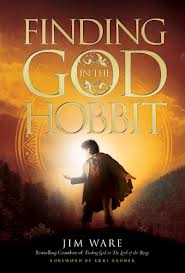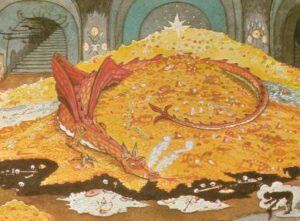Welcome to Week 2 of our Hobbit Read Along! (If you missed it, here’s Week One.) How’s the reading going at your house (or school or church)? If you’re having trouble finding time to read, you might enjoy this post I did a while back on the Book Whisperer’s list of funny places/times to read. Sometimes, the most creative thing about reading is finding a time and place to do it!
HOT CHOCOLATE–for hobbits, trolls, and kids with food allergies!
 Probably the greatest adventure I’ve taken in terms of food and drink has been diagnosing and dealing with the food allergies of my kids and my husband. My oldest has at least three genuine allergies, and more than twenty food intolerances that don’t show up on allergy tests. Since we discovered them, I’ve had to learn to cook with a whole new set of ingredients. Many of you may either have kids with food allergies or friends that do. Others of you may be looking for ways to make your family’s meals more healthy and nutritious without sacrificing taste. So, for this week’s recipe, I thought I’d share this one from Elena’s Pantry, a pretty nifty allergy-friendly website.
Probably the greatest adventure I’ve taken in terms of food and drink has been diagnosing and dealing with the food allergies of my kids and my husband. My oldest has at least three genuine allergies, and more than twenty food intolerances that don’t show up on allergy tests. Since we discovered them, I’ve had to learn to cook with a whole new set of ingredients. Many of you may either have kids with food allergies or friends that do. Others of you may be looking for ways to make your family’s meals more healthy and nutritious without sacrificing taste. So, for this week’s recipe, I thought I’d share this one from Elena’s Pantry, a pretty nifty allergy-friendly website.
Just a note: a lot of recipes and products will say they are allergy-free, but that’s misleading. Usually, it means they are free of the top five or ten allergens (peanut, soy, milk, etc.), but someone like my daughter is allergic to many things beyond those top allergens. So, even if a recipe or product says “allergy-free”, always check with the child’s parents before serving it. Still, if you’re looking for a recipe to serve when your kids bring their friends with food allergies over, today’s recipe for Peppermint Hot Chocolate in the download below is a great one to try.
Guest Host: Jim Ware
 I am so excited to welcome Jim Ware to the blog for the next couple of weeks. Actually, we’ll be drawing on his insights in Finding God in The Hobbit throughout the read along.
I am so excited to welcome Jim Ware to the blog for the next couple of weeks. Actually, we’ll be drawing on his insights in Finding God in The Hobbit throughout the read along.
Jim is a writer for Focus on the Family, and he’s written numerous books for kids and families including Adventures in Odyssey, God of the Fairy Tale: Finding Truth in the Land of Make-Believe, and of course the resource we’ll be consulting, Finding God in the The Hobbit. He also co-wrote Finding God in the Lord of the Rings
and Finding God in the Land of Narnia (Saltriver)
with Kurt Bruner. In addition, Jim has written his own fantasy series, The Stone of Destiny: A Novel
, which I only just found out about and hope to review before long. He says of this series,
I wrote THE STONE OF DESTINY for two reasons. First, I love fantasy, and I wanted to treat my readers to a rollicking good story. Second, I was hoping to invent a tale that illustrates the difference between faith and ‘magic’ – in other words, the difference between trust and a grab for power.
Last week, I asked our read along participants to put on their detective hats and see if they could find hints of God and His truth in the story as they read. Today, I thought we would start with perhaps the easiest place to find Him: in the bad guys of the story.
 That may sound a little strange at first. How can bad guys point us to God? Before Jim and I jump in on the subject, here are few thoughts for adults and older kids to get you thinking:
That may sound a little strange at first. How can bad guys point us to God? Before Jim and I jump in on the subject, here are few thoughts for adults and older kids to get you thinking:
- Evil is a corruption of something good: First of all, think about Genesis and God’s story. Consider how confused we would be if we didn’t understand that God made everything good, but man’s sin corrupted it. We might believe, as many Eastern religions put forth, that evil and good are two sides of the same coin in a never-ending struggle. Or we might believe, like many Moderns and postmoderns, that evil is just a construct or cultural preference that we can’t ever really be sure about. A right understanding of evil is critical in God’s story, and it will be in Tolkien’s, too. (We talk about this in the podcast below…)
- Evil is self-destructive: The Biblical idea of evil is that it isn’t a match for God in the long run. God has his use for it now, but ultimately, it will be destroyed. In Tolkien’s trolls, you see a clear picture of this, though it may be harder to see in the smarter villains. As Jim Ware puts it:
the gigantic, ogreish, and troll-like threat of the dark realm is, in the final analysis, ephemeral and passing—that given time, it will eventually implode by virtue of its own fatuity and senselessness. “Here,” as John the Revelator so memorably puts it, “is the patience and the faith of the saints” (Revelation 13:10). Martin Luther expresses it this way: The prince of darkness grim, We tremble not for him; His rage we can endure, For lo! his doom is sure: One little word shall fell him.
- Evil is confounded by wisdom: Why does Bilbo talk to Gollum and Smaug in riddles? Perhaps because evil is often vain, and short-sighted, and loves the thrill of the chase. In his book, Jim points out this has an interesting parallel to Christ’s parables, which he used to bless His followers, but which confounded and confused his enemies:
Jesus took a similar tack in dealing with some of the dragons He had to face during His time on earth—dragons like unbelief, apathy, and stubborn resistance to the truth. He didn’t challenge these serpents to a knock-down, drag-out battle. He didn’t always speak plainly, laying it all out for everyone to see, friend and foe alike. Instead, knowing the human heart as intimately as He does (John 2:24-25), He spoke shrewdly and winsomely to the dragon that lurked in its depths. He said things calculated to stir its curiosity. He revealed the fullness of His glory only to a select few. To the rest He talked in riddles—parables, as the Gospel writers call them.
- In God’s providence, evil is used for good ends: We talk more about this in the podcast, but it is no mistake that Tolkien’s idea of providence plays a big role in his stories. As the Bible says, “Even the wrath of men shall praise Him.”
 Evil itself points to God: Another point we don’t talk about below, but which is still worth mentioning is this. When someone like Hitler comes along and inflicts pain and death on untold millions, suddenly even the most skeptical among us want to say that what Hitler did was wrong. Not just impolite or anti-social, but really evil in some ultimate sense. But for something to be really wrong, for Hitler to have broken the rules so to speak, there must be rules to be broken. And where do we get those rules if not from a Creator God? The most succinct way I’ve heard it put is by Ravi Zacharias. He teaches a syllogism something like this:
Evil itself points to God: Another point we don’t talk about below, but which is still worth mentioning is this. When someone like Hitler comes along and inflicts pain and death on untold millions, suddenly even the most skeptical among us want to say that what Hitler did was wrong. Not just impolite or anti-social, but really evil in some ultimate sense. But for something to be really wrong, for Hitler to have broken the rules so to speak, there must be rules to be broken. And where do we get those rules if not from a Creator God? The most succinct way I’ve heard it put is by Ravi Zacharias. He teaches a syllogism something like this:
1. If there is evil, there also has to be good.
2. If there is good, there must be transcendent moral laws to define good.
3. If there are transcendent moral laws, there must be a transcendent moral law-giver. (i.e., God.)
THE PODCAST w/ Jim Ware
How do Tolkien’s villain’s show us God? We’ve barely begun the conversation, so we hope you and your family will listen and use to start your own discussion. Be sure to use the download below for more ideas, and leave us your thoughts in the comments below!
(Spoiler alert–this does mention that Bilbo and his traveling companions leave the path in Mirkwood. However, not much detail is given and it’s pretty crucial to the discussion, so I’ve included it here. If you’re concerned, though, you might wait to listen until after you’ve read that part of the book.)
[powerpress] ***podcast currently unavailable***
THE CONTEST
Don’t forget about our radio theater contest! You can find out more about the rules in the download below, but you don’t need to do the read along to enter. Just pick a few pages of The Hobbit and let your kids try reading them in a fun way. Do your best Smaug or troll voices, and email me the files at emily@redeemedreader.com. We’ll put the top three or four on our website and let our readers vote for a winner the last week of the read along. Deadline for entry is Monday, Nov. 26th!
HOBBIT READ ALONG GUIDE, WEEK TWO
These are the resources you may want to print off if you’re actually doing the read along. (I hope the rest of the post will be interesting for folks regardless.) It includes the read along schedule, the week’s main idea, games/discussion questions, the radio theater contest, and of course, the week’s hot chocolate recipe. Hope you enjoy!
CLICK HERE to download the guide as .pdf.
SUPPORT REDEEMED READER
One last quick note: if you like what we’re doing, there’s a quick and easy way to support us. Next time you want to buy something on Amazon.com, click through any link to Amazon on our site and make your purchases (for instance, the widget on the sidebar). You pay nothing extra, but we get a very small kickback for every dollar you spent. Unfortunately, we won’t have any way to thank you personally, but please know we appreciate it more than we can say.
Discussion
As you go through the reading, feel free to post questions, thoughts, and insights below for other readers! For instance, who do you think is Tolkien’s “best” villain? What makes him/her/it so scary?
Support our writers and help keep Redeemed Reader ad-free by joining the Redeemed Reader Fellowship.
Stay Up to Date!
Get the information you need to make wise choices about books for your children and teens.
Our weekly newsletter includes our latest reviews, related links from around the web, a featured book list, book trivia, and more. We never sell your information. You may unsubscribe at any time.
We'd love to hear from you!
Our comments are now limited to our members (both Silver and Golden Key). Members, you just need to log in with your normal log-in credentials!
Not a member yet? You can join the Silver Key ($2.99/month) for a free 2-week trial. Cancel at any time. Find out more about membership here.
6 Comments
Leave a Comment
You must be logged in to post a comment.



What a thought-provoking post! I love the parallel between the riddles and Christ’s parables. I had not made that connection before.
Thanks, Celeste! So glad you found something helpful!
Just wanted to say thank you for this wonderful website. You’re doing some amazing things. I pray you will be blessed in this work for Him.
Thank you, Ashlea. How I covet those prayers!
Reading this with my son now. I was disappointed to see the study guide link above leads to a file named study guide two but is otherwise identical to study guide one.
You’re right, Dianne, in that there is an error on the second download. But I just forgot to the change the header. The content of both the first and second downloads are correct. Will email you a corrected one tonight!